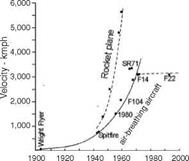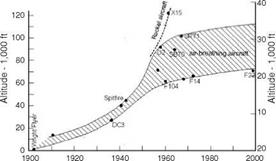Aircraft Classification, Statistics, and Choices for Configuration
4.1 Overview
This chapter presents important information on aircraft configuration that is required in Chapter 6 coursework. The current design and configuration parameters from aircraft production and operations serve as a template for identifying considerations that could influence new designs with improvements.
During the last century, many aircraft configurations have appeared; today, most of those are not relevant to current practice. Older designs, no matter how good they were, cannot compete with today’s designs. This book addresses only those well-established designs as shown in the recent Jane’s All the World’s Aircraft Manual; however, references are made to interesting and unique older aircraft configurations. The chapter starts by examining growth patterns in the aircraft operational envelope (e. g., speed-altitude capabilities). It continues with a classification of generic aircraft types that show distinct patterns within the class in order to narrow down the wide variety of choices available. Statistics is a powerful tool for establishing design trends, and some pertinent statistical parameters are provided herein.
This chapter compiles the available choices for aircraft-component configurations, including types of wing planform, fuselage shape, intake shapes and positioning, and empennage arrangements. These are the “building blocks” for shaping an aircraft, and as many configurations as possible are described. Artistic aesthetics are considered as long as they do not unduly penalize cost and performance – everyone appreciates the attractive streamline aircraft shapes. The new Boeing 787 Dreamliner (see Figure 1.8) shape is a good example of the company’s latest subsonic commercial transport aircraft. It is interesting that the Dreamliner configuration transitioned to the new B787 with more conventional aeroshaping. The B787’s advances in technology were not as radical an aerodynamic venture compared to Boeing’s earlier Sonic Cruiser proposal (see Figure 1.7), which was shelved. These decisions were made by one of the world’s biggest and best companies; the Sonic Cruiser was not a fantasy – it simply was not timed with market demand. It signifies the importance of conducting a market study, as emphasized in Chapter 2.
Civil and military aircraft design are discussed separately because of the differences in their mission roles (see Table 2.2).
4.1.1 What Is to Be Learned?
This chapter covers the following topics:
 Chapter introduction
Chapter introduction
Evolutionary patterns in current aircraft design trends and their
classification into distinct categories
Civil aircraft mission (domain served, role of economics)
Civil aircraft statistics (template for new design)
Civil aircraft component geometries (possible options)
Fuselage group (e. g., statistics, options)
Wing group (e. g., statistics, options)
Empennage group (e. g., statistics, options)
Nacelle group (e. g., statistics, options)
Summary of civil aircraft design choices Military aircraft detailed classification Military aircraft mission (domain served)
Military aircraft statistics (template for new design)
Military aircraft component geometries (possible options) Fuselage group (e. g., statistics, options)
Wing group (e. g., statistics, options)
Empennage group (e. g., statistics, options)
Nacelle group (e. g., statistics, options)
Undercarriage
Miscellaneous
Summary of military aircraft design choices
4.1.2 Coursework Content
The author recommends that readers browse through this chapter even though there is no coursework involved yet. This information is essential for designers, and this chapter will be better understood after reading Chapter 11 on aircraft sizing and engine matching to finalize the design. Readers will use the information provided in this chapter in Chapter 6.
4.2 Introduction
Previous designs have a strong influence on future designs – real-life experience has no substitute and is dependable. It is therefore important that past information be properly synthesized by studying statistical trends and examining all aspects of any influencing parameters in shaping a new aircraft – this is one of the goals of this book. Many types of aircraft are in production serving different sector requirements – the civil and military missions differ substantially. It is important to classify aircraft categories in order to identify strong trends existing within each class.
Existing patterns of correlation (through regression analysis) within a class of aircraft indicate what may be expected from a new design. There are no surprise elements until new research establishes a radical change in technology or designers
 |
 |
Year Year
(a) Speed (b) Altitude
Figure 4.1. Aircraft operational envelope
introduce a new class of aircraft (e. g., Airbus 380). In civil aircraft design, a 10 to 15% improvement in the operating economics of current designs within the class is considered good; a 20% improvement is excellent. Of course, economic improvements must be supported by gains in safety, reliability, and maintainability, which in turn add to the cost.
Readers are encouraged to examine the potential emerging design trends within an aircraft class. In general, new commercial aircraft designs are extensions of existing designs that conservatively incorporate newer, proven technologies (some result from declassified military applications). Currently, the dominant aerodynamic design trends show diminishing returns on investment. Structure technologies seek suitable new materials (e. g., composites, metal alloys, and smart adaptive materials) if they can reduce cost, weight, or provide aerodynamic gains. Engine design still needs aerodynamic improvements to save on fuel consumption and/or weight. Chapter 1 highlights that the current challenge lies in manufacturing philosophy, better maintainability, and reliability incorporating vastly improved and miniaturized systems (including microprocessor-based avionics for control, navigation, communication, and monitoring). This book briefly addresses these topics, particularly from the weight-saving perspective. It also describes conventional aerodynamic and structural considerations and available types of power plants.











